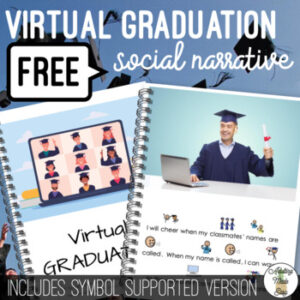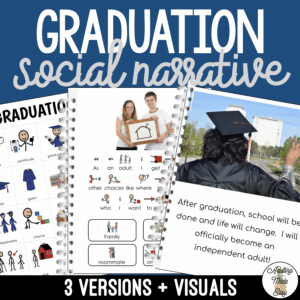Are you teaching high school or adult-aged students in special education? As you know, the focus during these years shifts heavily toward functional academics, life skills, and vocational training to help students prepare for life beyond the public school system. As secondary educators, it’s our responsibility to support students in becoming as independent as possible before graduation—whether they’re working toward living on their own, continuing to live with family, or transitioning to a group home setting.
No matter the path, building the skills to manage daily tasks and care for themselves is key.
Below are some practical ways you can structure your classroom to encourage age-appropriate behaviors, foster independence, and help students successfully transition into adulthood. This is a helpful resource for educators—and a valuable read for parents, too!
Start Early
Begin transition planning well before senior year to give students ample time to build necessary skills and explore options. Transitions are hard – so make sure to give students enough time and the tools they need to succeed.
Age-Respectful Resources & Materials
I’ll be the first to say it—there’s a noticeable shortage of resources and teaching materials specifically designed for secondary special education. As a new teacher, this can make classroom planning feel overwhelming, especially when starting from scratch.
This lack of resources can lead educators to fall back on materials that aren’t always age-appropriate or respectful of their students’ developmental stage. And while it might seem obvious to say, “Use age-appropriate materials,” it’s a reminder worth repeating—especially when you’re in a pinch and trying to make things work with limited options.
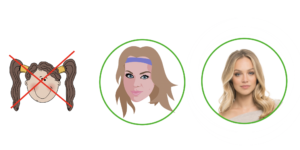
Don’t get me wrong—there are plenty of excellent life skills resources available. However, many of them are designed with younger learners in mind, often featuring playful clip art, whimsical fonts, and childlike themes. While these materials are well-made, engaging, and effective for teaching content, they’re not always appropriate for older students.
If you’re working with high school or adult-aged students, it’s important to transition away from materials intended for younger children. Using age-appropriate resources helps maintain dignity, promotes engagement, and better prepares students for real-world expectations.
Reading Materials & Books
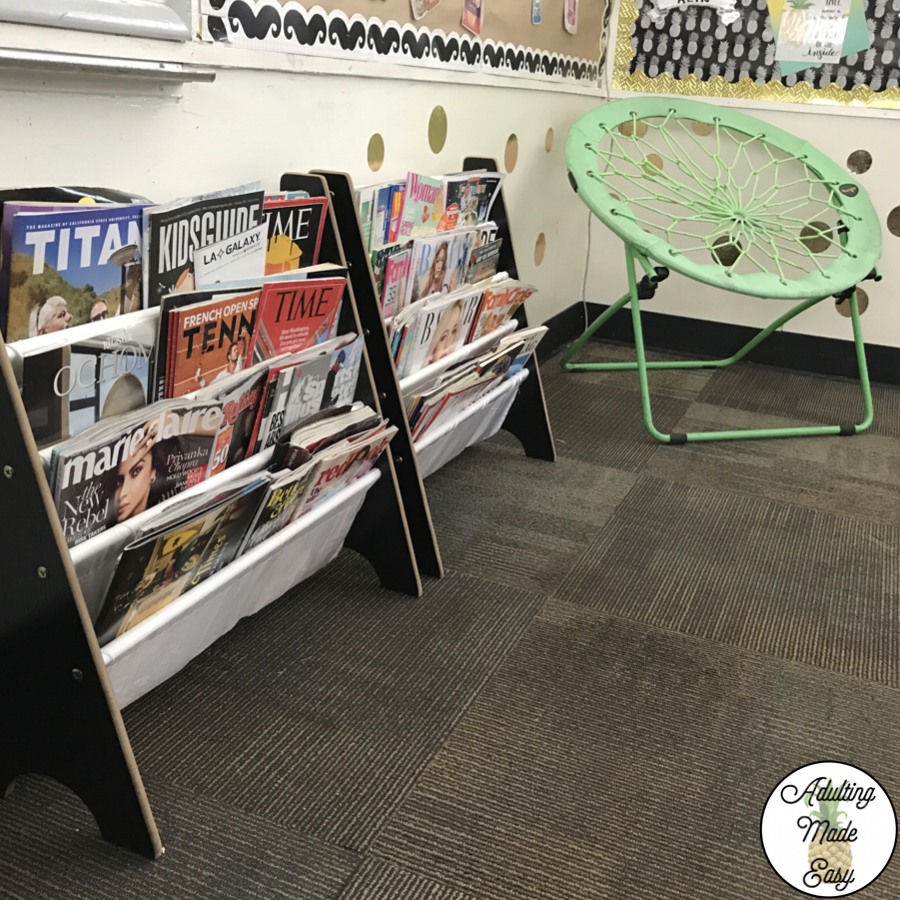
This also applies to the reading materials you keep in your classroom. I’ll be honest—finding leveled books that are truly appropriate for older students can be a real challenge. However, I’ve managed to collect a small selection of age-appropriate social stories and adapted books over time.
In the meantime, I supplement with magazines. They serve a dual purpose: students can enjoy them during leisure time, and we also use them for a variety of cut-and-paste activities that reinforce comprehension and fine motor skills.
Here is a website that has adapted literature and below are a few simplified & visual materials for students to read.
-
Product on sale
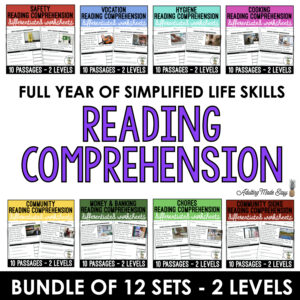 Life Skills Simplified Reading Comprehension Worksheet BUNDLEOriginal price was: $39.00.$29.99Current price is: $29.99.
Life Skills Simplified Reading Comprehension Worksheet BUNDLEOriginal price was: $39.00.$29.99Current price is: $29.99. -
Product on sale
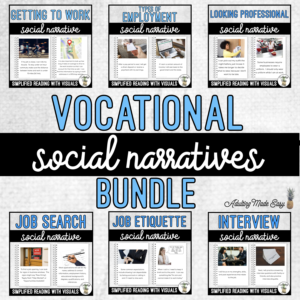 Vocational Social Narratives BUNDLEOriginal price was: $35.50.$29.99Current price is: $29.99.
Vocational Social Narratives BUNDLEOriginal price was: $35.50.$29.99Current price is: $29.99. -
Product on sale
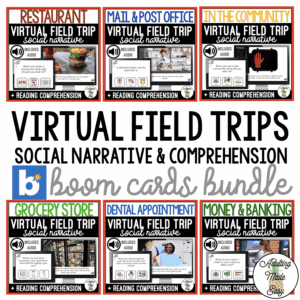 Virtual Field Trip Social Narrative & Comprehension BOOM CARDS BUNDLE SSOriginal price was: $48.00.$34.99Current price is: $34.99.
Virtual Field Trip Social Narrative & Comprehension BOOM CARDS BUNDLE SSOriginal price was: $48.00.$34.99Current price is: $34.99.
Treat them their age, not their functioning level
Let’s say you have an 18-year-old student functioning at a 3rd-grade academic level. In this case, your high school or transition curriculum should be modified—not replaced—to meet their needs. The key is to take content that’s age-appropriate for an 18-year-old and simplify it in a way that’s accessible, using age-appropriate visuals and supports when necessary. It’s important to remember that while the academic level may be lower, your student is still a young adult and likely doesn’t want to be treated like a child.
Now, what if your student genuinely enjoys something like Barney or Blue’s Clues? Respecting a student’s age means offering age-appropriate experiences in ways they can understand—but that doesn’t mean stripping away the things they love. Many adults enjoy cartoons, video games, or Disney—myself included!
As educators, our role is to prepare students for the real world while honoring their individuality and maintaining their dignity. Finding the right balance is key, and it should always be personalized to the student.
Ditch the Desks
No matter what grade your student is in, you’ll want to promote socialization of course. Once they hit hs/transition age, you’ll really want to make a push for it even more so. Focus on appropriate greetings, topics, and body language. Read social stories, often. Make more opportunities for socialization in and out of the classroom.
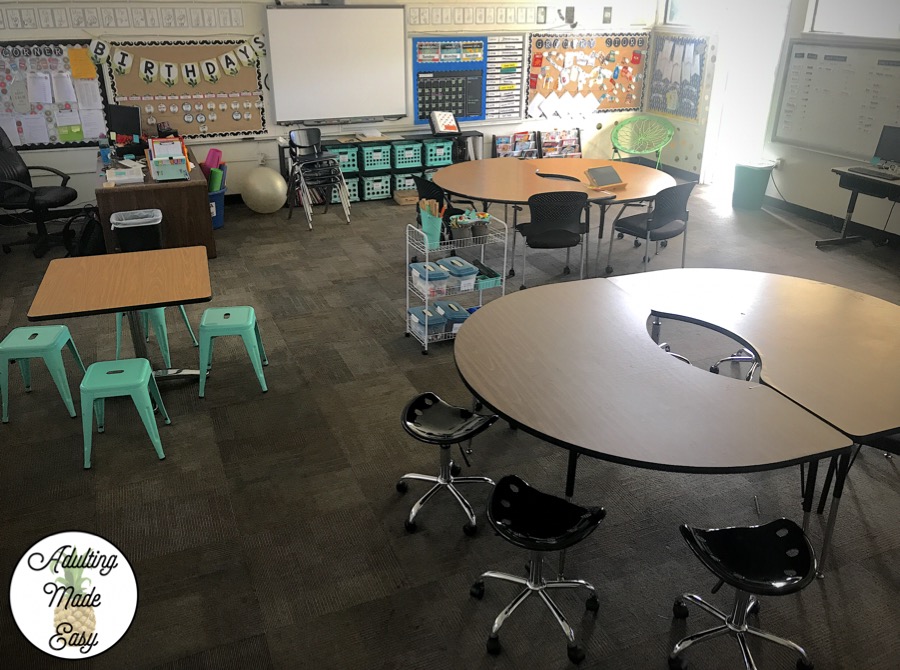
One effective way to encourage social interaction is to move away from traditional desks and create a classroom environment that feels more like a home or community hang-out space.
Using group tables instead of individual desks not only supports socialization but also mirrors real-world settings students are likely to encounter—such as events, meetings, or group activities in the community.
In my experience, this setup has led to increased peer interaction, improved skills in turn-taking, sharing, and respecting personal space. It’s also made small group instruction much smoother to facilitate—and it serves as a great example of flexible seating in action!
Environmental Print
Incorporate as many real-life materials and examples of environmental print as possible into your lessons. There are plenty of free, easy-to-access resources you can use—like magazines, restaurant menus, newspapers, brochures, and more. These everyday items help make learning more relevant and meaningful.
For example, weekly store circulars can be great tools for teaching nutrition, budgeting, or money math skills in a real-world context.
-
Product on sale
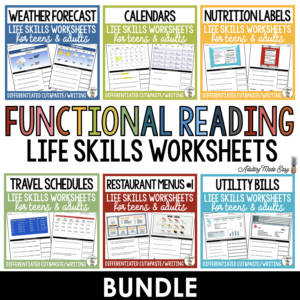 Functional Reading Life Skills Worksheets BUNDLEOriginal price was: $101.00.$79.99Current price is: $79.99.
Functional Reading Life Skills Worksheets BUNDLEOriginal price was: $101.00.$79.99Current price is: $79.99. -
Product on sale
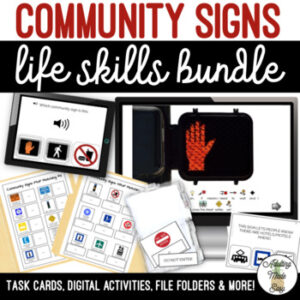 Community Signs BundleOriginal price was: $62.00.$45.00Current price is: $45.00.
Community Signs BundleOriginal price was: $62.00.$45.00Current price is: $45.00. -
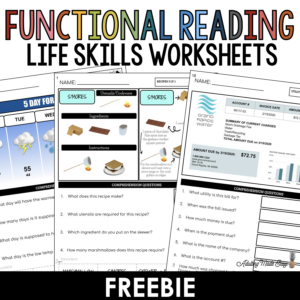 Functional Reading Life Skills Worksheets FREEBIE$0.00
Functional Reading Life Skills Worksheets FREEBIE$0.00 -
Product on sale
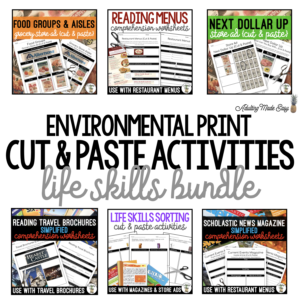 Environmental Print {Cut & Paste} Life Skills Activities BUNDLEOriginal price was: $17.75.$10.99Current price is: $10.99.
Environmental Print {Cut & Paste} Life Skills Activities BUNDLEOriginal price was: $17.75.$10.99Current price is: $10.99.
Reinforcement
Just as you would at any age, be sure to positively reinforce appropriate, age-expected behaviors. For secondary students, I do my best to avoid using token boards whenever possible. The goal is to promote greater independence, and gradually fading out token systems can help with that. If a student is currently using a token system, it’s worth discussing with the IEP team whether it might be an appropriate time to begin phasing it out—if doing so would support the student’s growth. If a token system is still needed, consider using real coins or money to incorporate functional math skills into the routine.

An alternative to traditional token boards is using a portable whiteboard with a checklist or task analysis. While it serves a similar purpose, it often appears more age-appropriate, encourages functional reading skills, and is easy to adapt—especially for students who enjoy having choices. Plus, it’s a time- and cost-effective option that doesn’t require laminating or Velcro.
Fade Away One-on-one aide
This is another important topic to bring to the IEP team for discussion—particularly if fading support seems appropriate. It’s certainly a significant decision, but one that can have a meaningful impact on the student’s long-term independence. Simply put, the less a student relies on one-on-one support, the more independent they can become.
In many cases, parents have worked hard to secure a one-on-one aide for their child, and that individualized support can be incredibly beneficial. However, as students approach their final year before graduation, it becomes essential to consider the broader picture. Promoting greater independence now can open up more opportunities for the student in adult day programs and post-graduation life.
Connect with Community Resources
Introduce students to vocational programs, college disability services, and local agencies that offer continued support after graduation. Many adult day programs operate with a staff-to-client ratio of approximately 1:3 or 1:4 and often have waitlists for enrollment. Most of these programs do not provide one-on-one support, so when evaluating potential clients, a key consideration is the individual’s level of independence.
Because of these factors, many families—often in collaboration with their regional center—begin exploring adult program options at the start of their student’s final school year. Ideally, efforts to gradually fade one-on-one support should begin by the end of the year prior to their “senior year,” giving students more time to build independence.
Securing a spot in an adult day program is much like a job interview. Programs frequently review a student’s present levels and may even schedule an observation at the school to determine fit.
When dropping the one-on-one isn’t an option…
If phasing out a one-on-one aide isn’t currently possible, that’s okay—there are still meaningful ways to promote greater independence. One approach is to focus on reducing the level of prompting or moving to the next step in the prompting hierarchy. While prompting hierarchies may vary, the general goal is to move toward more natural or gestural prompts.
Another important consideration is the aide’s proximity. When direct assistance isn’t required, encourage the aide to begin taking a step back. This helps the student become more comfortable operating independently, without feeling like someone is constantly by their side.
Discussions and Social Narratives
It’s crucial to begin conversations about graduation and life after school well in advance. Waiting until just a few months before graduation can create unnecessary stress and confusion. Starting early gives students more time to process the transition, which can help reduce anxiety.
In my experience, it’s common to see changes in behavior during a student’s final year—especially in the months leading up to graduation. Even students who typically don’t exhibit challenging behaviors may become more agitated or aggressive. Remember, behavior is a form of communication, and this can often be their way of expressing uncertainty or anxiety about the future.
One helpful strategy for easing these tensions is to engage in regular discussions and use visual social stories. These tools can provide structure, reassurance, and clarity during what can be a very emotional time. Take a look at this narrative:
Functional Classroom Decorations
Keep classroom décor minimal and purposeful—prioritize function over flash. Instead of traditional classroom decorations, consider drawing inspiration from real-world environments like homes, break rooms, or community spaces such as grocery stores. Decorate your walls with items students might see in everyday life to create a more authentic, relatable setting. Shift away from a typical “classroom” feel and incorporate environmental print. For example, instead of displaying classroom rules, try hanging framed motivational quotes to promote a more natural, engaging atmosphere.
Focus on functional academics and hands-on activities like cooking, cleaning, and vocational tasks. My classroom includes a variety of cooking and cleaning tools, along with vocational task boxes designed to build real-world skills. With just a few years remaining before graduation, this is the perfect time to apply what students have learned by simulating real-life situations in a structured and supportive environment.
-
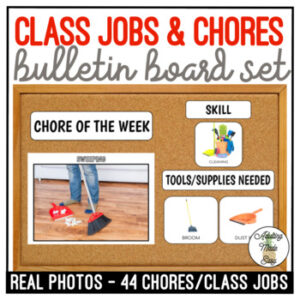 Classroom Jobs & Chores Bulletin Board Visuals$5.00
Classroom Jobs & Chores Bulletin Board Visuals$5.00 -
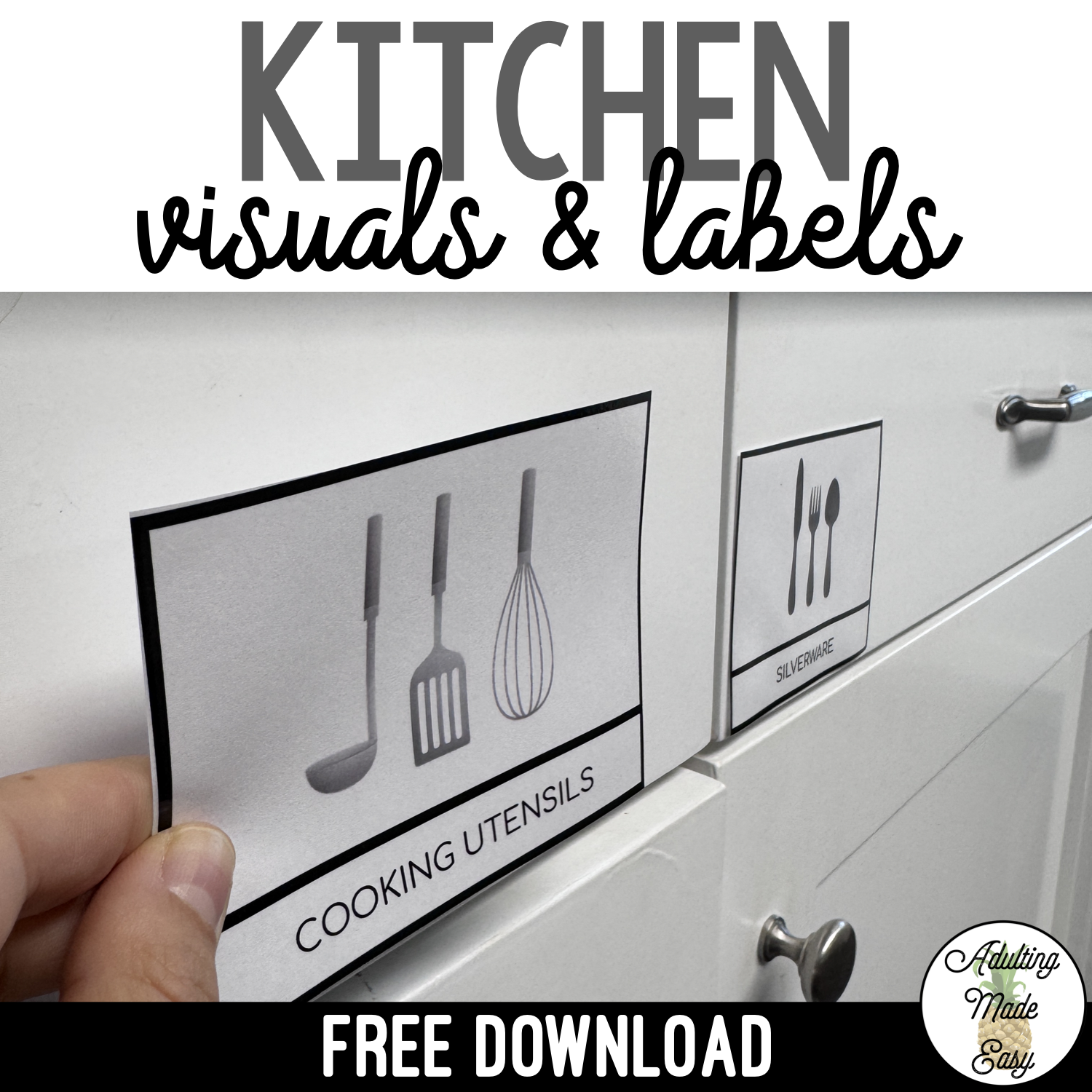 Kitchen Visuals & Labels FREEBIE$0.00
Kitchen Visuals & Labels FREEBIE$0.00 -
Product on sale
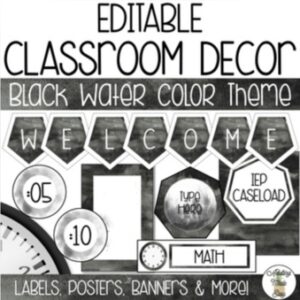 EDITABLE Black Watercolor Classroom Theme BUNDLEOriginal price was: $20.50.$13.25Current price is: $13.25.
EDITABLE Black Watercolor Classroom Theme BUNDLEOriginal price was: $20.50.$13.25Current price is: $13.25. -
Product on sale
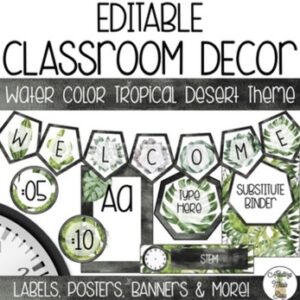 EDITABLE Watercolor Tropical Desert Classroom Theme BUNDLEOriginal price was: $24.00.$16.99Current price is: $16.99.
EDITABLE Watercolor Tropical Desert Classroom Theme BUNDLEOriginal price was: $24.00.$16.99Current price is: $16.99.
Hands-On Activities
Take advantage of every opportunity to practice vocational skills! I keep a variety of tools in my classroom specifically for building work-related abilities, many of which also reinforce important independent living skills like cleaning or basic home maintenance. One of the best parts of adult transition is that nearly every moment can become a teaching moment.
Need to pick up supplies? That’s a chance for community-based instruction. Something needs to be cleaned or repaired? That’s a perfect opportunity to work on life skills. Embracing these real-world tasks helps students build confidence and independence in meaningful, practical ways.
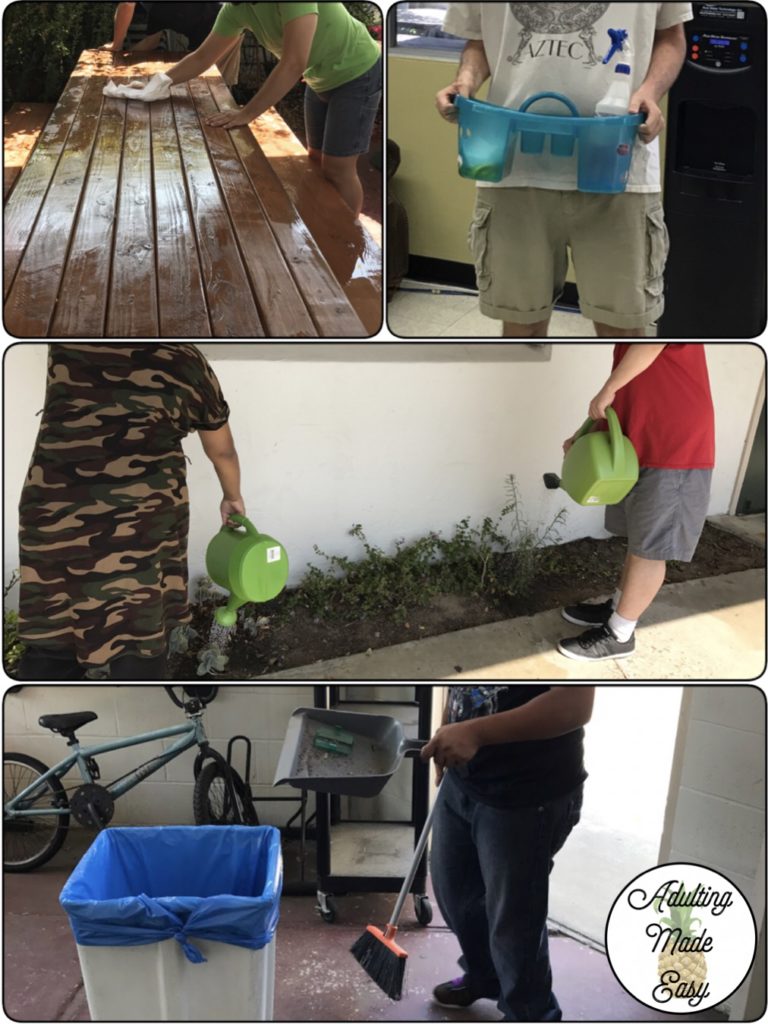
Cooking
If your school doesn’t have access to a full kitchen, consider equipping your classroom with portable cooking appliances like a hot plate, convection oven, microwave, or griddle. Cooking is a fantastic, hands-on activity that’s especially valuable in a secondary special education setting. I aim to have my students cook at least once a week, using recipes we find on Pinterest or ones that tie into current lessons—like those from N2Y. If your school does have a kitchen available, that’s a great resource to take advantage of!
At my school, the shared kitchen tends to get crowded, so we’ve invested in our own set of basic cooking tools for the classroom. We use appliances such as a hot plate, convection oven, blender, griddle, and microwave. We also have essential kitchen items like pots, pans, and dishes for preparing and serving meals. And of course, we incorporate life skills practice by having students wash the dishes afterward!
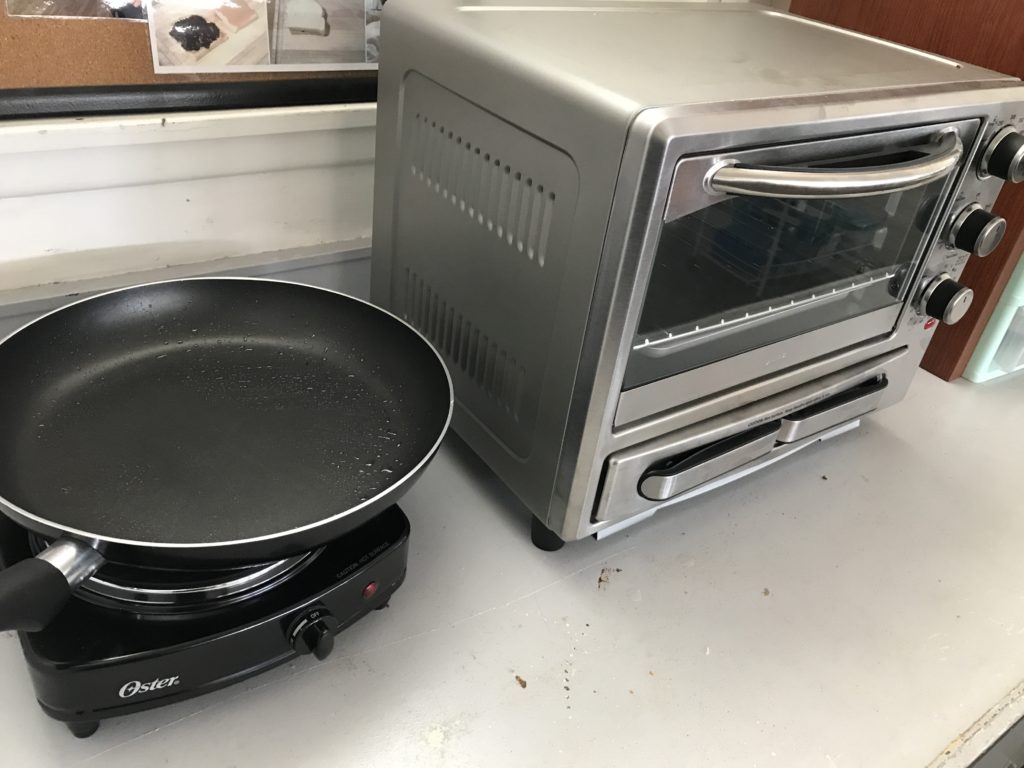
Independent Skills
A clothing rack can serve multiple purposes in the classroom. Use it to practice hanging jackets, store extra clothing for accidents, and keep professional attire—like dress shirts and slacks—for off-campus job opportunities. You can also include job coaching shirts if needed. Additionally, students can take these clothes, along with laundry from other classrooms, to a local coin-operated laundromat each week to practice essential laundry and life skills in a real-world setting.
Community-Based Instruction
Take advantage of every opportunity to get off campus and into the community! If it’s appropriate for the student, consider securing public bus or train passes to support travel training. Even regular walks around the school’s neighborhood can help students become more familiar with their surroundings while also encouraging a healthy, active lifestyle.
Community-based instruction can take many forms—grocery shopping, ordering food at a restaurant, reading maps or bus schedules, exploring job opportunities, or even doing scavenger hunts to build navigation and observation skills. These real-world experiences are invaluable for building independence and confidence.
-
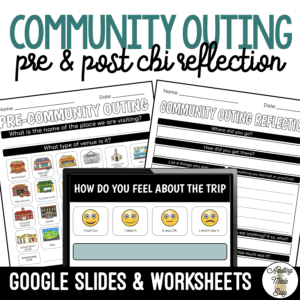 Community Outing CBI Visual Reflection Worksheets$3.00
Community Outing CBI Visual Reflection Worksheets$3.00 -
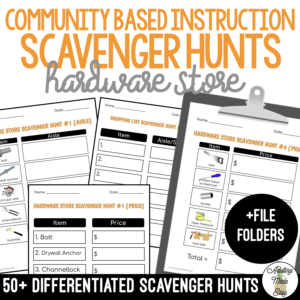 Hardware Store CBI Scavenger Hunt Activities$3.00
Hardware Store CBI Scavenger Hunt Activities$3.00 -
Product on sale
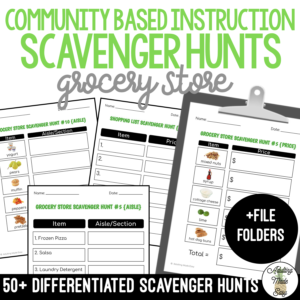 Grocery Store CBI Scavenger Hunt Activities & File FoldersOriginal price was: $3.99.$3.00Current price is: $3.00.
Grocery Store CBI Scavenger Hunt Activities & File FoldersOriginal price was: $3.99.$3.00Current price is: $3.00. -
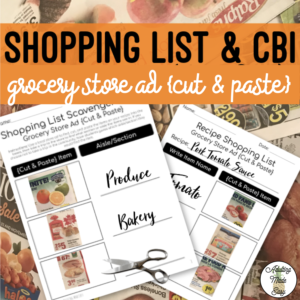 Shopping List & CBI – Store Ad {Cut & Paste} Worksheets$1.00
Shopping List & CBI – Store Ad {Cut & Paste} Worksheets$1.00
There’s no better way to teach real-life skills than by engaging directly with the community. Community-based instruction not only benefits students—it can also bring a great sense of relief to parents. With the guidance and support provided by teachers and aides, students have a structured and safe way to gain confidence in real-world settings, making community outings more manageable and meaningful.
When students learn how to navigate the community successfully at school, they’re more likely to demonstrate those same skills with their families—leading to more positive experiences for everyone. Confident students make for confident, happy parents!
Learn about all of the different opportunities to go off campus to incorporate community-based instruction here:
Vocational Skills
Whether it’s through work task boxes, task cards, or on- or off-campus job experiences, vocational skills practice is essential in any life skills classroom. There are countless opportunities to create meaningful job roles right on campus—or even within the classroom itself—to help students develop and strengthen their work readiness skills.
One wall in my classroom is dedicated to job timesheets, which supports one of our key vocational goals. Students complete their timesheets several times a week, recording their “clock in” and “clock out” times for both on- and off-campus jobs. Having them displayed helps students remember to complete them consistently and also serves as valuable work samples.
If your school participates in the WorkAbility program, students may even earn a paycheck for their efforts. Alternatively, you can implement your own classroom reward system to recognize and reinforce their hard work.
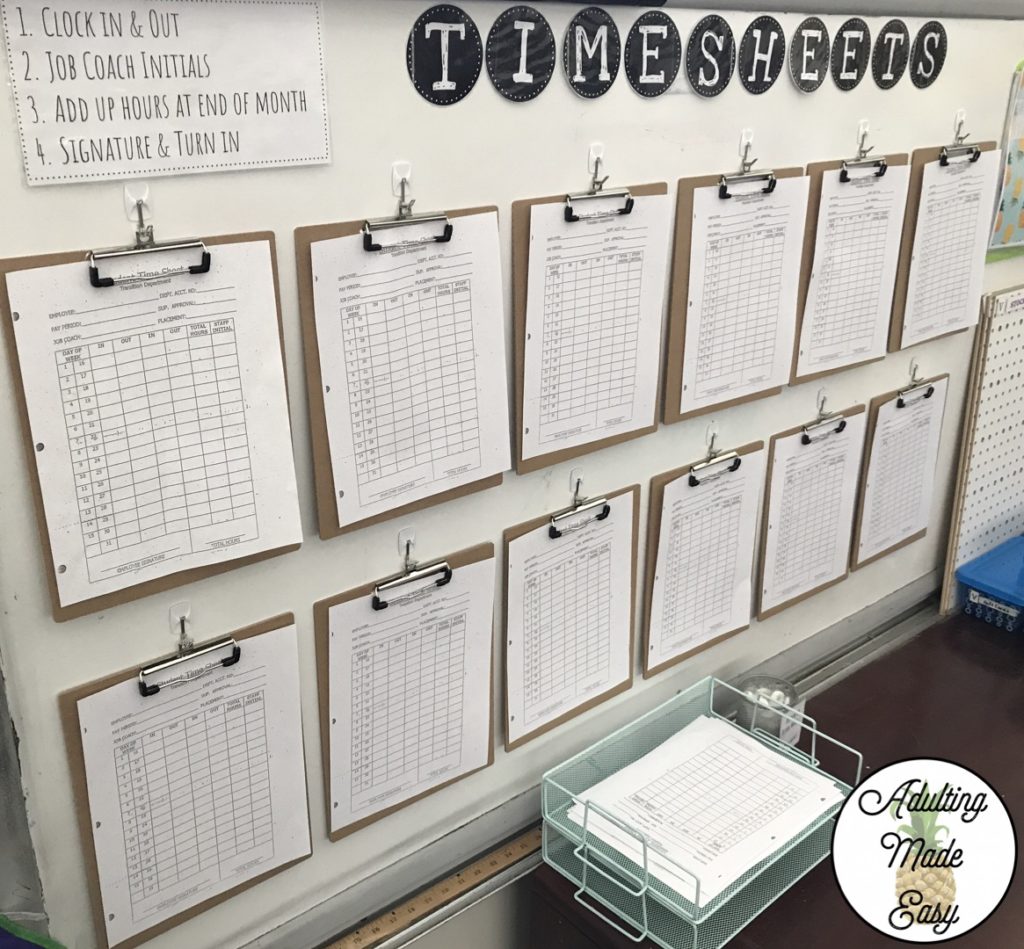
A great vocational activity to incorporate into your routine is the Vocational Question of the Day or Independent Living Question of the Day. This can be paired with an interest tracking sheet to help monitor students’ preferences and strengths, which is especially useful for future planning.
In addition, have students regularly practice their personal information—such as name, address, and phone number. Once they’ve mastered that, you can begin introducing job applications and résumé writing. There are many differentiated and simplified formats available to meet students at their individual levels.
As graduation approaches, support students in creating an official résumé that includes the skills they’ve developed, their job preferences, and any relevant work experience. Be sure to list yourself (and/or related service providers who know the student well) as a reference. This document can be used for future job interviews, program applications, or continued development as students gain more experience.
-
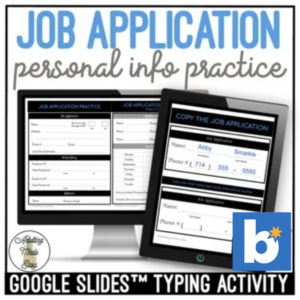 Job Application Practice Google Slides & Boom Cards Typing Activity$3.00
Job Application Practice Google Slides & Boom Cards Typing Activity$3.00 -
Product on sale
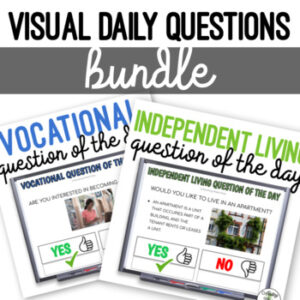 Visual Daily Question of The Day BundleOriginal price was: $12.00.$8.99Current price is: $8.99.
Visual Daily Question of The Day BundleOriginal price was: $12.00.$8.99Current price is: $8.99. -
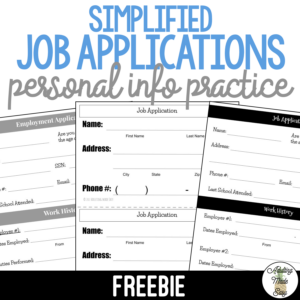 Simplified Job Application Worksheets FREEBIE$0.00
Simplified Job Application Worksheets FREEBIE$0.00 -
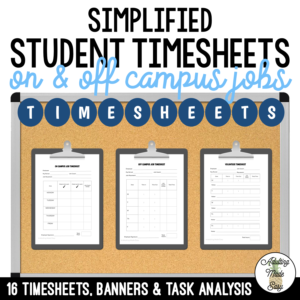 Simplified Vocational Timesheets$2.00
Simplified Vocational Timesheets$2.00
Starting a student-run business is another fantastic way to build vocational skills in a meaningful and engaging way! It offers hands-on experience in areas like teamwork, responsibility, money management, and customer service. For ideas and guidance on how to get started, be sure to check out this blog post!
Practice Self-Reflection
Encourage students to reflect on their strengths, interests, and areas for growth to help shape post-graduation plans.
Disclaimer: The content provided in this blog is circumstantial to different variables such as student learning styles or accommodations… etc. Strategies provided should always be discussed with the parents and IEP team before implementation.
Thanks for reading!


